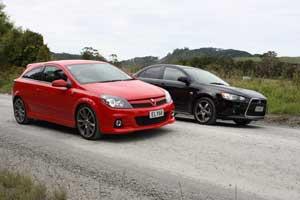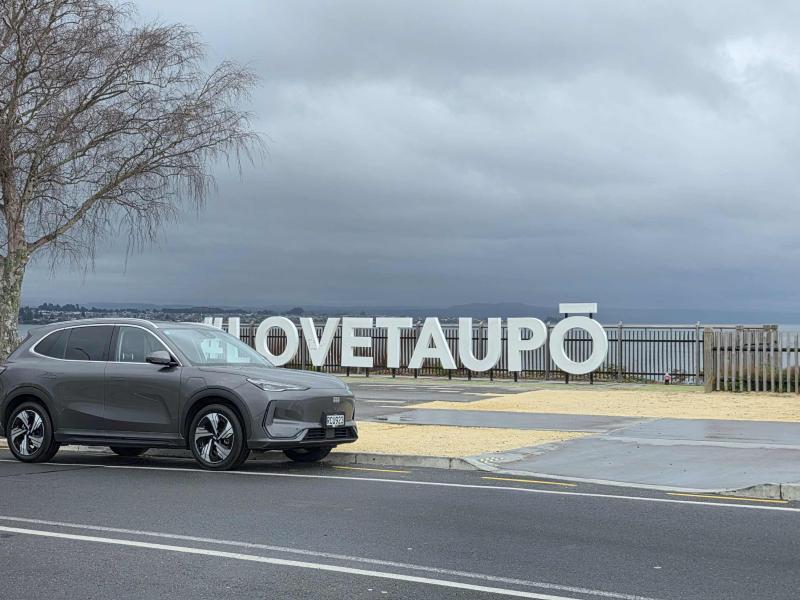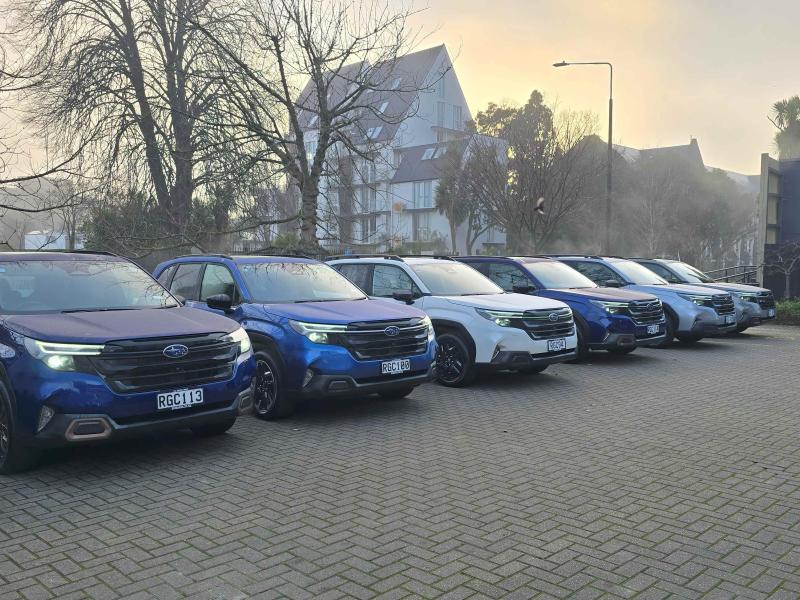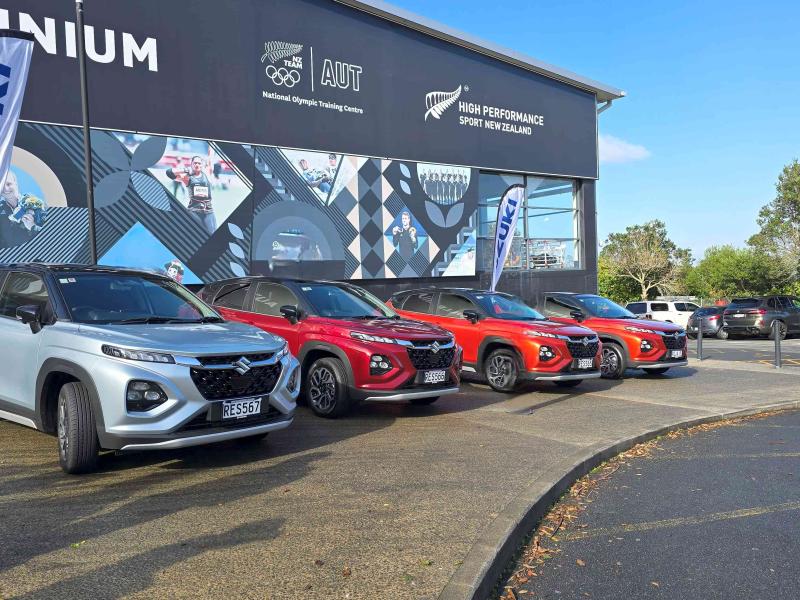|
The heat is on in middle management user-chooser land to downsize from the usual six-cylinder Falco-dores, but the fifty thousand dollar question is what do you get to enjoy power, performance and economy? The answer is a turbocharged four-cylinder powerhouse. Enter stage left the HSV Astra VXR (Red Baron) and the Mitsubishi Lancer Ralliart (Black Ninja). Before you think that New Zealand Company Vehicle has gone mad and turned into Boy Racer magazine we’d like to point out that you can have your cake and eat it too. It was a happy accident that we managed to acquire both the VXR and the Ralliart for evaluation over the same week, and an even happier accident when we discovered that both have a $49,990 retail price. Downsizing for economy has never been so much fun. Both cars have 2.0 litre turbocharged four-cylinder engines. The Ralliart has 180kW under the bonnet and the VXR pumps out 177kW, both through six-speed transmissions. However, there is a fundamental difference in drive train. The German bred VXR is front wheel drive and has a traditional manual gearbox while the all-wheel-drive Ralliart sports an automated twin-clutch transmission. So which is the better option? We headed out to our favourite piece of road for an in depth evaluation with Mr Oxley at the wheel with his driving gloves on: Mitsubishi Ralliart We found the suspension was firm but not harsh. The Recaro seats are comfortable and hold one beautifully in tight corners. However the high built-in head restraints limit rear vision somewhat when feeding into traffic from a side road. The rear vision is also restricted by the boot spoiler. The boot is not huge, and it’s got a great big bass speaker inset into the side. The gearbox is fantastic on the open road, responding almost as quickly as you can think. However around town it tends to be a bit “clunky”, though, again, not enough to put us off owning one. Using sport mode in the auto setting makes the engine rev higher, and gives over-run braking when decelerating. We also liked the big paddles behind the steering, which make it easy to change gear even if the wheel is turned. The handling of the Ralliart is unbelievable. The car tracks like on rails, with great turn-in. There is a degree of under-steer if you drive too hard and braked while in the corner, but if you brake before the corner the weight transfer off the front when you lift off the brakes cuts this under-steer to a minimum. Or you can turn the DSC off and the tail will come around a bit. When the DSC switched itself off the handling actually improved as it allowed a bit of tail-out on tight corners. The DSC did switch off when the brakes got hot, but there was no fade and the brakes kept working well. The engine also ran hot when we were pressing on – I would have expected this car would be able to take hard treatment without this occurring. The engine is neatly fitted under the bonnet, but the prop stand is a bit low rent for a car in this price bracket. But overall fit and finish of the Ralliart was excellent, with no rattles whatever. The seats were nicely form-fitting. That said they will only fit a certain size, larger bottoms need not apply! The Front leg room is good, but space in the back is a bit limited. This is not a big car by any means. Big points to Mitsubishi for fitting the excellent Xenon head lights. It’s good to see them coming down into the sub (just) $50,000 bracket. The “keyless” entry device works on proximity like Mercedes. So you never have to get the device out of your pocket. Once you’re in you can start the car without using the key – but you have to turn a key-like device on the ignition. Not even a racy push-button! So what’s the point? You can see the brake calipers through the racy wheels, but they’re rather scruff-looking things, not like the smart painted ones as on the HSV Astra or the Golf GTI. A very involving car when driven really fast, the way it was designed. We’d certainly buy one. Specifications: Body type Four-door sedan Drive All-wheel-drive Engine Type Inline 4-cylinder turbocharged Engine Capacity 1998cc Max power 180kW @ 6000 rpm Max torque 349Nm @ 3000 rpm Fuel Consumption 10L/100km C02 emission 233g/km 0 to 100kph N/a Front suspension McPherson Strut Rear suspension Independent multi link Roof Rack N/a ABS Brakes Yes Air Bags 7 ESP Yes Air Conditioning Climate Lap/diagonal belts 5 Satellite Navigation N/a Electric seats N/a Burglar Alarm Yes Panic Button N/a Boot release Yes Cargo Cover N/a Boot Capacity 239 Litres Wheel type 18-inch Spare Tyre Space saver |
The VXR was beautifully finished with typical German attention to details except for an annoying vibration noise, which I think was coming from the driver’s door. We liked the gas strut which held the bonnet open. Being a 3-door hatch it’s quite difficult to get in the back as headroom is not great. But there’s more knee room than you get in the Mitsubishi, once you’re in. Rear vision good for reversing, but the rear window is quite small, made even worse by the dirty great HSV sticker someone has slapped on it. However the boot space is good, and the seats flop forward easily to increase this. BUT unlike the Mitsubishi there’s hardly anywhere to put stuff in the cabin. I put my cellphone in the SINGLE cupholder, which is just about in the back, so you’re likely to leave your phone in the car. Performance is excellent, with HUGH bottom end torque. You can stay in sixth right down to about 50 km/h, and it will still pull without balking. The gear change is super-slick, but never as good as the Mitsubishis twin clutch arrangement. The handling is good, but a lot more under-steer than the Mitsubishi since all the power is being fed through the front wheels. In Sport mode the ESP hardly cuts in at all, allowing one to really get to grips with the car. That said, it’s a lot harder to drive fast in the HSV – you have to wrestle with the car more, as suspension isn’t as firm as the Ralliart, with a bit more body roll. Having said that, my time for the return journey was about the same as I did in the Ralliart, so it just goes to show the cars are quite evenly matched in real terms. But I definitely had to work harder. The ESP stayed on, but the brakes were also hot like the Ralliart, and the pedal started to get a bit long and softish towards the end of the run. But engine temperature stayed on normal. Even though the car was bright red it didn’t turn as many heads as the Ralliart. I tend to think this one is aimed at a more mature target segment than the Japanese product. A gentleman’s racer rather than a boy racer. I liked the nicely painted blue brake calipers. Both cars have a lot of engineering depth in them, lots of motor sport background, and it shows. It’s hard to say which one I’d prefer in my garage, though I tend more towards the Holden. It’s more practical as a day-to-day car, except that most of us these days prefer an automatic to a manual gearbox. But HSV doesn’t have a double clutch ’box, and not even a very good automatic in this segment. Oh, and the car has a definite identity crisis. HSV badges on the bonnet and hatchback but OPC on the dashboard and VXR on the steering wheel and kick plates. Specifications: Body type Three-door hatchback Drive Front-wheel-drive Engine Type Inline 4-cylinder turbocharged Engine Capacity 1998cc Max power 177kW @ 5600 rpm Max torque 320Nm @ 2400 rpm Fuel Consumption 9.2l/100km 0 to 100kph 6.2 secs Front suspension McPherson Strut Rear suspension Torsion beam Roof Rack Optional ABS Brakes Yes Air Bags 6 ESP Yes Air Conditioning Yes Lap/diagonal belts 4 Satellite Navigation N/a Electric seats N/a Burglar Alarm Yes Panic Button No Boot release Yes Cargo Cover Yes Boot Capacity n/a Wheel type 19-inch alloy Spare Tyre full size
|
Red Baron or Black Ninja, thats the $50,000 question.
Road Report
Friday, 30 March 2012
File Download:






